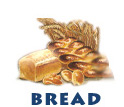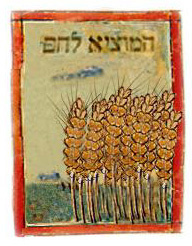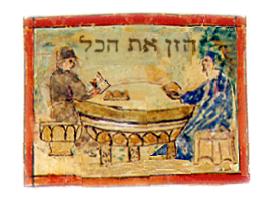

The
most hallowed of the domestic prayer experiences were those that accompanied
every meal, especially the Sabbath and festival meals, when the whole family
participated in the recital of the prayers. The opening benediction before
the meal is the brief blessing in which God is praised and thanked for "bringing
forth bread from the earth." Bread,
in this blessing, is the symbol of all food and includes the whole meal irrespective
of the variety of dishes served. The recitation of this blessing, known as
the Hamotzi (Who brings forth [bread from the earth]), was already
widespread in rabbinic times. Thus, an innkeeper is quoted in the Midrash
as saying to a fellow Jew: "When I saw that you ate without washing your hands
and without a blessing, I thought you were an idolater."[1] Bread,
in this blessing, is the symbol of all food and includes the whole meal irrespective
of the variety of dishes served. The recitation of this blessing, known as
the Hamotzi (Who brings forth [bread from the earth]), was already
widespread in rabbinic times. Thus, an innkeeper is quoted in the Midrash
as saying to a fellow Jew: "When I saw that you ate without washing your hands
and without a blessing, I thought you were an idolater."[1]
The devotions after the meal made up for the brevity of the Hamotzi.
They constitute a well-constructed and deeply moving prayer unit of four bulky
benedictions. In these benedictions the Jew thanks God in accordance with
the biblical injunction: "When you have eaten your fill, give thanks to the
Lord your God for the good land which He has given you."[2]
Accordingly, the first benediction thanks God for the blessing of food, and
the second benediction for "the good land" that He gave to Israel as an inheritance.
The third benediction thanks God for His merciful restoration of Jerusalem.
To be sure, Jerusalem was in ruins; nonetheless, the benediction is in the
present tense — "who rebuilds Jerusalem." The redemption
of Israel will materialize at any moment, perhaps at the very moment when
the benediction is being recited....

The three initial benedictions of Birkat ha-Mazon (the Blessing for
the Food, often translated Grace after Meals) are among the most ancient
prayers in the Jewish liturgy. The rabbis emphasize their antiquity by ascribing
them to Moses, Joshua and King Solomon, respectively. The Talmud teaches:
Moses instituted
for Israel the [first] benediction [of the grace] —
"Who feeds" — at the time when the manna descended
for them. Joshua instituted for them the [second] benediction of the land
when they entered the land. David and Solomon instituted the [third] benediction
which closes "Who builds Jerusalem."[3]
A fourth benediction, called "Ha-tov veha-meitiv" (Who is good and
does good) is a later addition, attributed by the rabbis to the period immediately
after the Bar Kokhba rebellion in the second century. At that time the remnants
of the Jewish people were threatened with extinction through a pestilence
caused by the many corpses strewn everywhere; when the Romans granted permission
to bury the dead, this benediction was instituted, thanking God for not
permitting Israel to perish.

With the passage of time the Birkat ha-Mazon expanded considerably
beyond the initial core. Thanksgiving prayers for a number of additional
blessings were incorporated in the first three benedictions. Among the divine
blessings for which thanks are expressed are the gifts of the Torah, the
covenant of Abraham, and the dynasty of David, one of whose descendants
will be the Messiah, according to tradition.
But it was the fourth
benediction that grew largest in size. People took more liberties with
it because it was the latest of the benedictions to be officially incorporated
into the Birkat ha-Mazon. A number of general supplications were
added to this benediction, each of which starts with the words "Ha-rahaman"
(May the all-merciful). The number of these Ha-rahaman verses vary
in different communities: Maimonides (Spain & Egypt, 12th cent.) lists
three; Yemenite Jews, four; Mahzor Vitry (France, 12th cent.),
twelve; the Sephardim, eighteen; the Roman rite, twenty-two; and modern
Ashkenazi custom, nine.
For the Sabbath a special prayer was added, and for the festivals and
New Moon days prayers were borrowed from the liturgy. At circumcisions
and wedding feasts, poetic interpolations are customary. There is also
a special form or recitation in the house of mourning. When three or more
adults[4]
participate in a meal, the Birkat ha-Mazon becomes a formal group
service and the leader opens with an invocation, "Rabbotai nevarekh" (Gentlemen,
let us say grace), a sort of official call to worship to which the participants
respond. The custom and formula are ancient and according to the Talmud,
as old as Shimeon ben Shetah.[5]
By the end of the geonic period (mid-sixth to mid-eleventh century), this
service had not only been formulated but also fully accepted. Only minor
accretions were added in the subsequent centuries. To this day the Birkat
ha-Mazon services those Jews who choose to express their gratitude
to God for the sustenance He has provided, for the world and its bounty.
|
[1]
Numbers Rabbah 20:21 [back]
[2] Deut. 8:10 [back]
[3] Babylonian Talmud Berakhot 48b [back]
[4] The invitatory formula is known as Zimmun,
while three or more adults who have eaten together represent a mezuman.
Traditionally, those counted are male, although according to the Talmud
three or more women who have eaten together should also recite Zimmun
(Berakhot 45b). Later rabbinic authorities were divided as to whether
a woman could be counted together with the men. The great majority
of non-Orthodox count participants of either sex (of Bar/Bat Mizvah
age), while Sephardim permit a boy over six who understands what he
is saying to be counted. [back]
[5] Jerusalem Talmud Berakhot 7:2 [back] |
|
 From:
Abraham Millgram's Jewish Worship (JPS, 1971, 1975). This
article, based on Millgram's presentation of the development of
Jewish liturgy, has been expanded for the purposes of this webzine
edition. From:
Abraham Millgram's Jewish Worship (JPS, 1971, 1975). This
article, based on Millgram's presentation of the development of
Jewish liturgy, has been expanded for the purposes of this webzine
edition.
|
|